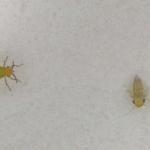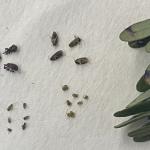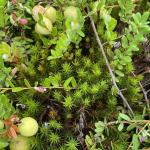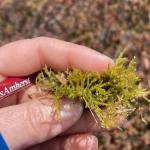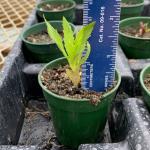MDAR Online Pesticide Use Reports are due June 30, 2024. You cannot submit hard copies. All reports must be submitted electronically. All licensed and certified pesticide applicators are required to submit annual reports of the quantities of all pesticides used. You can find the form here. Each product is entered using the EPA Registration Number, which then autofills. If you are having terrible trouble, call Marty (508-265-6921).
Insects.
Hopefully bogs are pretty clean now! It is too late to spray for green spanworm or blackheaded fireworm. Most of the larvae have completed development, pupated, and the first moths of both species have started flying. Weevil sprays should be wrapping up as bees have started to arrive. The Koppert bumblebees arrived today and the Biobest bumblebees are being sent out next week. The migratory honeybee companies have dropped hives at launch sites and have started to deliver hives to bog sites at night.
Unfortunately, it is still too early to spray for scale! The females have just started to produce eggs. Crawlers will likely develop next week. They are not vulnerable to insecticides until the crawlers are released. Hold off on sprays until that time. We estimate the best timing will be the end of next week. This continues to put us in a very hard place.
Black bug and blunt nosed leafhopper continue to be found on some bogs. Black bug nymphs are a bit bigger now and green. Leafhopper nymphs continue to be tiny and can be yellow, white or a bit darker. Both are cause for concern.
Disease.
As we are rapidly approaching bloom (and even seeing open flowers in some spots already), you should have your plan ready for fruit rot fungicides. The Final Keeping Quality has not yet been calculated, but the Preliminary forecast for the 2024 Massachusetts cranberry crop is VERY POOR!
Remember that most fruit rot infections occur during bloom and early fruit set. Once the fruit has set and begun to increase in size (mid-late July), fungicides are no longer necessary or effective.
Your first application should happen when the bed is between 10-50% bloom, with many growers opting for starting when around 30% of flowers are open. If you are considering using broad-spectrum fungicides such as chlorothalonil (e.g., Bravo) and/or mancozeb (e.g., Manzate Max) as part of your fungicide regime, it is recommended to use them when the maximum number of flowers are open (early to mid-bloom).
Do not apply more than two applications of Group 3 and Group 11 fungicides (eg. Proline, QuadrisTop, Indar and Abound) due to resistance concerns.
Copper fungicides (eg. Kocide 3000, Badge SC, Champ, Mastercop), if chosen, should be applied late bloom.
Weeds.
Haircap moss (Polytrichum commune) has been the most widespread and “weedy” moss on MA cranberry in recent years. Unlike the sphagnum mosses that are found in wet spots and can be partially managed by improving drainage, haircap moss grows well in dry areas and can significantly reduce cranberry yields. I have heard from a few growers questioning whether Zeus/Spartan is not working as well on moss this year. I have not seen the sites in question, but have a theory based on what we are seeing on State Bog.
We had excellent results controlling haircap moss with Zeus. After two years of use, the once widespread and dense haircap moss is now only found in small patches on our farm. However, there is now another species of moss (or perhaps a few different species) that seems to be thriving now that the haircap moss is gone. Nature hates a vacuum! The sulfentrazone does not seem to control these other mosses as well as it controls haircap moss. The main species we found on State Bog was identified as bog groove-moss or ribbed bog moss (Aulacomnium palustre).
If you feel like sulfentrazone did not work well for moss this year, let me know. I would like to see what kinds of moss you have on your farm. If you do have haircap moss, it can take weeks or even months after herbicide application to see the full effects of sulfentrazone, so efficacy may improve over time.
Fireweed (aka American burn weed; Erechtites hieraciifolius) was a big problem for some growers last year. This is an annual weed (germinates from seed, flowers, and dies every year). If you had it last year, and did not treat with a preemergence herbicide, be on the lookout. Although it is unknown exactly when it germinates on MA cranberry beds, it is likely late spring – early summer (now).
Research conducted on lowbush blueberry fields* shows that mesotrione (Callisto) can be used to control fireweed postemergence BUT timing will be critical!!!! The study showed it was highly effective on small plants, but not on larger plants (almost 100% control on plants 1.5” tall and almost 0 control on plants over 6.5’ tall). Scout and treat when plants are small.
*White SN, Webb C. Susceptibility of American burnweed (Erechtites hieraciifolius) to herbicides and clipping in wild blueberry (Vaccinium angustifolium). Canadian journal of plant science. 2017;98
Fertilizer.
This is not the time of year for heavy fertilizer use. When cranberry reaches hook stage, some growers apply a modest application of nitrogen ranging from 5 to 13 lb N/acre (up to 20% of the total nitrogen needed for the season). The best fertilizer use efficiency occurs during fruiting (75% in bloom/early set, occurring late June/early July). At this time, fertilizer application should be made applying approximately 55% of the total nitrogen needed for the season. Another application can be timed for 75% out of bloom (late set) to deliver the remainder of the nitrogen needed for the season.
If you have specific questions about fertilizer, please feel free to contact Peter at peterj@umass.edu
Other notes.
The Cranberry Station is hosting a Coffee Chat on Wednesday, June 12, 2024, between 9:00-11:00 AM. Do you want to chat about what’s happening on your bog? Have a question about a weed or something you can’t identify? Stop by the Station, grab a cup of coffee, a snack and talk with scientists and fellow growers. Bring a sample from your bog and take a look under the microscope. We are looking forward to seeing you!
